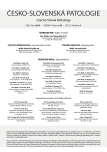Use of archival formalin-fixed, paraffin-embedded (FFPE) tissue samples for molecular genetic analysis in diffuse large B-cell lymphoma (DLBCL)
Authors:
Marie Jarošová; Jana Kučerová; Patrik Flodr; Michaela Mikešová; Vít Procházka; Tomáš Papajík
Authors‘ workplace:
Hemato-onkologická klinika FN a LF UP Olomouc
1; Ústav biologie LF UP Olomouc
2; Ústav klinické a molekulární patologie FN a LF UP Olomouc
3
Published in:
Čes.-slov. Patol., 50, 2014, No. 2, p. 95-99
Category:
Original Article
Overview
The currently valid molecular genetic subclassification of patients with diffuse large B-cell lymphoma (DLBCL) into three prognostic subgroups based on expression profiling has been the objective of numerous genetic studies. In routine clinical practice, however, expression profiling technology remains unavailable for the most of centers. Apart from the technology, in some cases molecular genetic laboratories have problems obtaining high-quality material, i.e. fresh tissues, for RNA isolation to determine gene expression. One possibility is to determine the gene expression from RNA obtained by isolation from formalin-fixed, paraffin-embedded (FFPE) tissue. This pilot study aimed at isolating RNA from FFPE in patients diagnosed with DLBCL and verifying the potential use of such RNA for the expression analysis of 7 selected genes. Although the study showed that it is possible to isolate RNA and determine the expression of the selected genes from archival material, the values of relative expression of some genes in the set were too variable to be used for unambiguous prognostic classification. It was confirmed that retrospective analyses of selected genes may be performed with sufficient material obtained, and that properly archived blocks may be used for molecular biology analyses even after 8 years.
Keywords:
DLBCL – FFPE – gene expression – qRT-PCR – genetic changes
Sources
1. Jaffe ES, Harris NL, Stein H, Vardiman JW, eds. Pathology and Genetics of Tumours Haematopoietic and Lymphoid Tissues. World Health Organization Classification of Tumours. Lyon, France: IARC Press; 2008.
2. Alizadeh AA, Eisen MB, Davis RE, et al. Distinct types of diffuse large B-cell lymphoma identified by gene expression profiling. Nature 2000; 403: 503-511.
3. Rosenwald A, et al. The use of molecular profiling to predict survival after chemotherapy for difuse large-B-cell lymphoma. N Engl J Med. 2002; 346: 1937–1947.
4. Hans CP, Weisenburger DD, Greiner TC, et al. Confirmation of the molecular classification of diffuse large B-cell lymphoma by immunohistochemistry using a tissue microarray. Blood 2004; 103: 275-282.
5. Choi WW, Weisenburger DD, Greiner TC, et al. A new immunostain algorithm classifies diffuse large B-cell lymphoma into molecular subtypes with high accuracy. Clin Cancer Res. 2009; 15: 5494-502.
6. Lenz G, et al. Molecular subtypes of diffuse large B-cell lymphoma arise by distinct genetic pathways. Proc Natl Acad Sci U S A. 2008; 105: 13520–13525.
7. Huang JZ, Sanger GW, Greiner TC, et al. The t(14;18) defines a unique subset of diffuse large B-cell lymphoma with a germinal center B-cell gene expression profile. Blood 2002; 99: 2285-2290.
8. Iqbal J, Greiner TC, Patel K, et al. Distinctive patterns of BCL6 molecular alterations and their functional consequences in different subgroups of diffuse large B-cell lymphoma. Leukemia 2007; 21: 2332-2343.
9. Pasqualucci L, Migliazza A, Basso K, et al. Mutations of the BCL6 proto-oncogene disrupt its negative autoregulation in diffuse large B-cell lymphoma. Blood. 2003; 101: 2914-23.
10. Morin RD, Johnson NA, Severson TM, et al. Somatic mutations altering EZH2 (Tyr641) in follicular and diffuse large B cell lymphomas of germinal-center origin. Nat Genet 2010; 42: 181–185.
11. Ye BH., Lista F, Lo Coco F, et al. Alterations of a zinc finger-encoding gene, BCL-6, in diffuse large-cell lymphoma. Science 1993; 262: 747-750.
12. Iqbal J, Sanger WG, Horsman DE, et al. BCL2 translocation defines a unique tumor subset within the germinal center B cell-like diffuse large B cell lymphoma. Am J Pathol 2004; 165: 159–166.
13. Compagno M, Lim WK, Grunn A, et al. Mutations of multiple genes cause deregulation of NF-kappaB in diffuse large B cell lymphoma. Nature 2009; 459: 717–721.
14. Cattoretti G, Angelin-Duclos C, Shaknovich R, et al. PRDM1/Blimp-1 is expressed in human B-lymphocytes committed to the plasma cell lineage. J Pathol 2000; 5206: 76–86.
15. Angelin-Duclos C, Cattoretti G, Lin KI, Calame K. Commitment of B lymphocytes to a plasma cell fate is associated with Blimp-1 expression in vivo. J Immunol 2000; 165: 5462-71.
16. Maldelbraum J, Bhagat G, Tang H, et al. BLIMP1 is a tumor suppressor gene frequently disrupted inactivated B cell like diffuse large B cell lymphoma. Cancer Cell 2010; 18: 568–579.
17. Pasqualucci L, Compagno M, Houldsworth J, et al. Inactivation of the PRDM1/BLIMP1 gene in diffuse large B cell lymphoma. JEM 2006; 203: 311-317.
18. Lossos IS, Czerwinski DK, Alizadeh AA, et al. Prediction of survival in diffuse large-B-cell lymphoma based on the expression of six genes. NEJM 2004; 350: 1828-37
19. Malumbres R, Chen J, Tibshirani R. et al. Paraffin-based 6-gene model predicts outcome in diffuse large B-cell lymphoma patients treated with R-CHOP. Blood 2008; 111: 5509-14.
Labels
Anatomical pathology Forensic medical examiner ToxicologyArticle was published in
Czecho-Slovak Pathology

2014 Issue 2
Most read in this issue
- WHO classification of tumours of soft tissue and bone 2013: the main changes compared to the 3rd edition
- Where does Ewing sarcoma end and begin - two cases of unusual bone tumors with t(20;22)(EWSR1-NFATc2) alteration
- The current staging for uterine body malignancies and its importance for clinical practice
- Epidermolytic hyperkeratosis of the vulva associated with basal cell carcinoma in a patient with vaginal condyloma acuminatum and vaginal intraepithelial neoplasia harboring HPV, type 42
